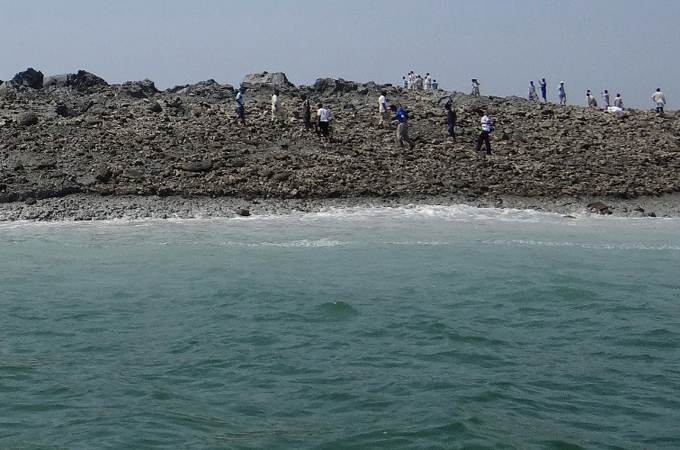Homeless Pakistan quake survivors await help
Victims of quake that left more than 350 dead struggle to survive as rugged terrain slows down relief efforts.

Survivors in southwestern Pakistan have been forced to spend the night in makeshift shelters built with sticks and bed sheets after their mud homes were flattened in a massive earthquake that killed hundreds.
The Pakistan National Disaster Authority put the death toll for Tuesday’s quake at more than 350, but sources told Al Jazeera that the number of the dead has already topped 500.
Keep reading
list of 4 itemsEnergy summit seeks to curb cooking habits that kill millions every year
Thousands evacuate as wildfire grows ‘dramatically’ in western Canada
Guardians of the glaciers – life alongside Pakistan’s vanishing ice
The 7.7 quake flattened wide swathes of Awaran district in Balochistan province, where it was centered, leaving much of the population homeless.
While waiting for help to reach remote villages, hungry people dug through the rubble to find food. The remoteness of the area and the lack of infrastructure hampered relief efforts.
|
|
| Exclusive report from Pakistan’s quake epicentre |
Al Jazeera’s Kamal Hyder, reporting from Awaran on Thursday, said conditions were desperate among the survivors and many were going without food, water and shelter, having lost everything in the quake.
In the village of Dalbadi, almost all of the 300 mud-brick homes in were destroyed. Noor Ahmad, a resident, said he was working when the quake struck and rushed home to find his house levelled and his wife and son dead.
“I’m broken,” he said. “I have lost my family.”
Doctors in the village treated some of the injured, but due to a scarcity of medicine and staff, they were mostly seen comforting residents.
“We need more tents, more medicine and more food,” said a spokesman for the provincial government, Jan Mohammad Bulaidi.
Jan Buledi, a spokesperson for the Balochistan government, told Al Jazeera that more than 2000 tents and food packages had reached the affected areas so far.
“We have reached the Awaran headquarters and many of the affected areas are very far away. As you can imagine, we have a many issues in getting aid to those areas,” Buledi said. “There is also the danger of militancy in these areas.”
The size of the area is considerable, he noted, more than 40 thousand square kilometres.
Village devastated
The Pakistani military said it had rushed almost 1,000 troops to the area overnight and was sending helicopters as well. A convoy of 60 Pakistani army trucks left the port city of Karachi early on Wednesday with supplies.
One survivor interviewed in his Karachi hospital bed said he was sleeping when the quake struck.
“I don’t know who brought me from Awaran to here in Karachi, but I feel back pain and severe pain in my whole body,” he said.
 |
| Residents were warned not to visit the new island because it was emitting dangerous gases [AFP] |
Balochistan is Pakistan’s largest province, but also the least populated.
Awaran district has about 300,000 residents spread out over 29,000 square kilometers (11,197 square miles).
The local economy consists mostly of smuggling fuel from Iran, or harvesting dates.
The area where the quake struck is at the centre of an insurgency that Baluch separatists have been waging against the Pakistani government for years.
It is also prone to earthquakes. A magnitude 7.8 quake centered just across the border in Iran killed at least 35 people in Pakistan last April.
Tuesday’s shaking was so violent it drove up mud and earth from the seafloor to create an island off the Pakistani coast.
New island
A Pakistani Navy team reached the island by midday Wednesday. Navy geologist Mohammed Danish told the country’s Geo Television that the mass was a little wider than a tennis court and slightly shorter than a football field.
The director of the National Seismic Monitoring Center confirmed that the mass was created by the quake and said scientists were trying to determine how it happened.
Zahid Rafi said such masses are sometimes created by the movement of gases locked in the earth that push mud to the surface.
“That big shock beneath the earth causes a lot of disturbance,” he said.
He said these types of islands can remain for a long time or eventually subside back into the ocean, depending on their makeup.
He warned residents not to visit the island because it was emitting dangerous gases.
But dozens of people went anyway, including the deputy commissioner of Gwadar district, Tufail Baloch.
Water bubbled along the edges of the island. The land was stable but the air smelled of gas that caught fire when people lit cigarettes, Baloch said.
Dead fish floated on the water’s surface while residents visited the island and took stones as souvenirs, he added.
The Balochistan government has declared a state of emergency in six quake-hit districts. It has also announced a budget of about $1.6 million for immediate rescue and relief.